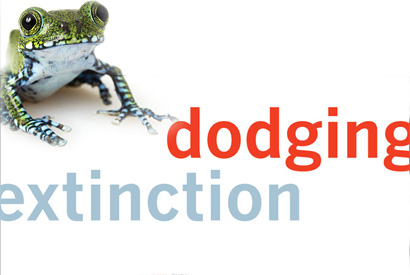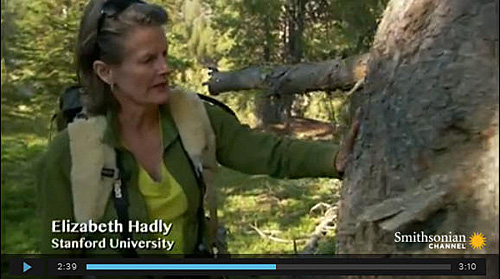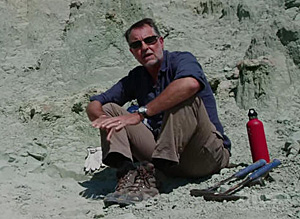Dodging a sixth mass extinction
Integrative biology professor Anthony Barnosky not only has a new book out, Dodging Extinction, but also appears in a new documentary airing Nov. 30 on the Smithsonian Channel. The film, Mass Extinction, Life at the Brink, also features UC Berkeley geologist Walter Alvarez and Barnosky's wife, Stanford ecologist Elizabeth Hadly.

November 25, 2014
Anthony Barnosky’s father was a butcher, his grandfather an underground coal miner. He himself, fresh out of college, worked for ARCO to locate new coal deposits in Colorado and later he worked for the Alyeska pipeline company in Alaska.
“Fossil fuels have been very, very good to me and very, very good to all of us,” says Barnosky, a paleontologist and UC Berkeley professor of integrative biology.
The irony, not lost on Barnosky, is that he now urges a ban on coal, replacing oil and gas with sustainable fuels and eating less meat to address the threat of climate change and a world hotter than it’s been in 14 million years.
Those are just a few of the suggestions Barnosky offers in his new book, Dodging Extinction (UC Press), which takes a close look at how our choices — what we eat, how we generate our energy, how we make money — affect the world around us, and how we can change our habits to prevent the calamity of a sixth global extinction like the one that wiped out the dinosaurs 66 million years ago.
“There are things we can do,” he says. “The sixth mass extinction is not a done deal. We have lost only one percent of the species that we have ridden the planet with for the last 12,000 years. We have thousands of species right now that are in pretty serious trouble, but every one of those can be turned around at this point in history — if we just do the right things. Laying out solutions, trying to get to the basics of what we need to do, is really why I wrote this book.”
Barnosky addresses some of these issues in a new documentary, Mass Extinction: Life at The Brink, airing Nov. 30 on the Smithsonian Channel. He appears with his wife, Stanford ecologist Elizabeth Hadly, and UC Berkeley’s Walter Alvarez, who with his late father, the physicist Luis Alvarez, first uncovered evidence that an asteroid impact caused the last mass extinction, the one that saw the demise of the dinosaurs.
Die-offs
In the four decades since Barnosky, with a B.A. in geology from Colorado College in Colorado Springs, first explored his home state for coal, he has seen dramatic changes resulting from global warming.
“I go back to these places where I was doing coal exploration geology — beautiful places in western Colorado — and now the trees are all dead, mostly from beetle kill because winters have warmed enough so that the beetles can reproduce twice in a season rather than once,” says Barnosky, now 62. “In my lifetime, I have seen it go from verdant forests to literally tens of thousands of acres of dead trees. And that’s not just in Colorado. There are literally millions of square miles of dead trees up and down the Rocky Mountain chain. All because of greenhouse gases warming the atmosphere.”

Ecologist Liz Hadly of Stanford University explains the damage done by bark beetles in the Rocky Mountains in this clip from the Smithsonian Channel’s documentary “Mass Extinction,” which also features her husband, UC Berkeley scientist Anthony Barnosky.
As a paleontologist, he knows that die-offs are common in Earth’s history, but the scale of today’s threat is potentially much larger than the planet has seen in millions of years, approaching that of five previous mass extinctions, which obliterated uncounted species now seen only in the fossil record.
Life experience as well as analysis of past extinctions have made him a vocal advocate for policy changes to slow greenhouse gas emissions and prevent a sixth mass extinction that could even include humans.
His 2009 book, Heatstroke: Nature in an Age of Global Warming (Island Press), laid out the changes in store for Earth if climate change is not halted. Then, in 2012, he worked with a group of 22 prestigious scientists from around the world to publish a paper in Nature warning that population growth, widespread destruction of natural ecosystems and climate change may be driving Earth toward a planet-wide tipping point that would have disastrous and irreversible consequences.
 California Gov. Jerry Brown saw the paper and called Barnosky to ask him to produce a concise summary of the evidence for climate change, what it means for the environment and the state, and what the state can do to mitigate the consequences. Barnosky, Hadly and other top global-change scientists handed the document to Brown in May 2013, endorsed by more than 500 fellow scientists, outlining the main environmental issues — from climate change to pollution and population growth — that policy makers must address immediately to avoid an approaching global tipping point.
California Gov. Jerry Brown saw the paper and called Barnosky to ask him to produce a concise summary of the evidence for climate change, what it means for the environment and the state, and what the state can do to mitigate the consequences. Barnosky, Hadly and other top global-change scientists handed the document to Brown in May 2013, endorsed by more than 500 fellow scientists, outlining the main environmental issues — from climate change to pollution and population growth — that policy makers must address immediately to avoid an approaching global tipping point.
Brown has placed the report in the hands of people around the world while working closely with the state Legislature to institute carbon-reduction goals, cap and trade and other policies to reduce the state’s carbon footprint.
“Working with Gov. Brown has been very rewarding. It’s gratifying to see the science being used in ways that actually affect policy decisions,” he says. “California is a great example of what can be done when people are motivated. We have got gridlock in Washington, but it doesn’t all have to happen at a national level.”
California and China, for example, have signed emission agreements and set up development of green technologies, “showing how states can use this problem as opportunities for economic development, which again is part of the solution. What you need are these win-wins.”
Win-wins
His book suggests other win-wins, such as::
- Eat less meat, for your health and the health of the environment. “I love meat. The question is: How do you make it possible for people to eat meat and still not trash the planet? And the answer is to eat a lot less of it, and make the meat that you do eat grass-fed beef or bison. It’s not that meat is bad, so don’t eat it. It’s really, feedlot beef is bad, so don’t eat it.”
- Before purchasing fish, consult the Monterey Bay Aquarium’s Seafood Watch app to check which fish have been sustainably harvested. “We have taken about 90 percent of the big fish out of the sea already. But in many cases we know how to sustainably manage these fisheries. With 7 billion people on the planet, we can’t rely solely on wild stocks, and fish farming is not necessarily a bad thing. Tilapia farms can be done sustainably, for example. But in order to have sustainable fish farms, we need a certain amount of regulation.”
- Don’t purchase foods — and that includes most junk foods — made with palm oil that comes from agricultural plantations that have expanded by cutting down rain forests. “Palm oil is one of the big causes of deforestation now. It turns up in so many different products: foods, cosmetics, soaps. We are not going to get rid of palm oil, but there are major corporations that have agreed not to use palm oil from newly deforested areas but only from sustainable palm oil plantations. Only buy products from those companies.”
Another strategy for saving Earth is to put dollar values on natural resources so that we won’t think of them as “free,” but rather as ecosystem services we need to preserve for our grandchildren, similar to how Coca-Cola recently declared water as a resource integral to its business.

Barnosky in the fossil beds of eastern Oregon. Courtesy of HHMI.
“A lot of it is starts with talking with your friends about the issues and building awareness and a social movement that political and business leaders will listen to,” he says.
Barnosky remains optimistic that change from the bottom will move legislators at the top to do something about climate change.
“It absolutely means we have to start now, though,” he says. “We have got this little window where we can really go into high gear and have a very substantial and good outcome. If we postpone this for 5 or 10 years, our chances of making it turn out all right are very much reduced.
He and Hadly will continue to beat the drum, having just finished – this time in collaboration – a new book called End Game: Tipping point for planet Earth?, due out next year from Thomas Dunne Books in United States and William Collins in the United Kingdom.
RELATED INFORMATION
- Biodiversity in the Age of Humans, a series of educational lectures by Barnosky and others, sponsored by the Howard Hughes Medical Institute’s BioInteractive
- The Barnosky lab
- The Hadly lab